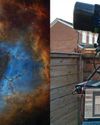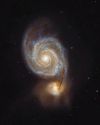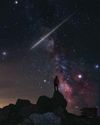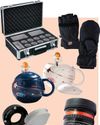
If you're a newcomer to the wonderful hobby of astronomy, your first time under a clear sky can be an overwhelming experience. How will you ever find your way around this vast number of stars?
Fortunately, there's a tried and tested method, developed over millennia, to turn this bewildering confusion of bright dots into a familiar recreation ground, and which works in bright and dark skies alike. It's called star-hopping.
What we do is make easily identifiable patterns (called asterisms) from the brightest stars and use these as jumping-off points to locate our desired target objects, and we estimate directions in relation to other stars - for example, "towards that bright yellowish star".
Estimating distances works in much the same way - for example "a third of the way from the lower star to the upper one" or a proportion of the field of view of your binoculars or telescope. Alternatively, if you stretch out your arm, you can use the distance covered by your fist or handspan to measure out the distance (most of us are more or less similarly proportioned for this purpose). Let's look at four star-hops to help test your skills.
Star-hop your way to the Pole Star
This story is from the {{IssueName}} edition of {{MagazineName}}.
Start your 7-day Magzter GOLD free trial to access thousands of curated premium stories, and 9,000+ magazines and newspapers.
Already a subscriber ? Sign In
This story is from the {{IssueName}} edition of {{MagazineName}}.
Start your 7-day Magzter GOLD free trial to access thousands of curated premium stories, and 9,000+ magazines and newspapers.
Already a subscriber? Sign In

Putting cosmic rays to work
These penetrating interstellar particles have applications from astronomy to archaeology

Set up your first imaging sequence
How to automate and coordinate your gear over multiple nights of imaging

The Universe without gravity
Life with no gravity might sound a fun idea, but as Govert Schilling explains, shutting off this pivotalforce would spell disaster for Earth and beyond

How to blend images taken with different camera setups
Combine data captured at varied focal lengths to create rich, deep images

INSIDE THE SKY AT NIGHT
Back in September 2021, The Sky at Night show spoke to Carly Howett about NASA's then upcoming Lucy mission. As the spacecraft now approaches its main targets - the Trojan asteroids - we check in with her to see how the mission is going

The science of SCI-FI
We love a good sci-fi film, but do they get the science right? Amy Arthur picks six of the big mistakes made in space films

Seeing in a new light
It's National Astronomy Week this month, so take a tip from Mark Westmoquette and let mindful stargazing change your perspective on your life and problems

What to do if you find a meteorite
Ever come across an unusual rock and wondered if it's a meteorite? Mark McIntyre explains how to tell if that stone really is a fragment from outer space

GEAR
Charlotte Daniels rounds up the latest astronomical accessories

Q&A WITH A STELLAR ECLIPSE SPECIALIST
Many stars are gravitationally locked inside multi-star systems, but a rare new triple-star system has set a new record for how cosy these clusters can get